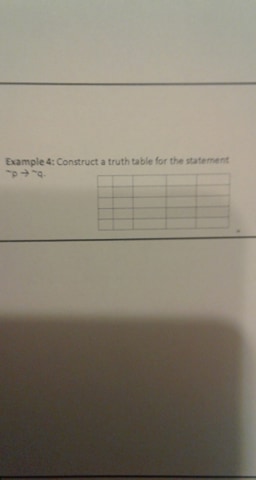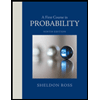
A First Course in Probability (10th Edition)
10th Edition
ISBN: 9780134753119
Author: Sheldon Ross
Publisher: PEARSON
expand_more
expand_more
format_list_bulleted
Question
thumb_up100%
How to construct truth tables and understand how to do them

Transcribed Image Text:Example 4: Construct a truth table for the statement
Expert Solution
This question has been solved!
Explore an expertly crafted, step-by-step solution for a thorough understanding of key concepts.
This is a popular solution
Trending nowThis is a popular solution!
Step by stepSolved in 2 steps with 2 images

Knowledge Booster
Learn more about
Need a deep-dive on the concept behind this application? Look no further. Learn more about this topic, probability and related others by exploring similar questions and additional content below.Similar questions
- 2. (P + Q)=(Q→P) Build the truth table. P P +Q Q +P According to the truth table you built, are these statements logically equivalent? Why or why not?arrow_forwardState our definition of “valid inference” and then explain how to use a truth table to test the validity of an inference in zeroth-order logic.arrow_forwardP∨¬(Q∧R), ¬(P∨R), ¬(P<->R) use truth table to see if consistentarrow_forward
- Use the truth table test of validity to determine whether the following arguments are valid or invalid. To be invalid, the premises will be true, but the conclusion false. INSTRUCTIONS: 1. First, identify and define the type of Truth Functional Connective each symbol represents and type it in to the first table. 2. Then, create a Formal Method Test of validity table below each argument to determine whether the argument is valid or invalid. 3. Indicate whether the argument is valid or invalid. If the argument is invalid, highlight the area on the table that proves it. A row for each possible outcome [2"] → Use the pattern of half the rows to make half of the values in the column true → For the next column keep using the pattern of half Remember to Create: Type in the meaning of the symbol in the space provided. Truth Functional Symbol How to determine its truth value Connective it represents V .. SAMPLE ARGUMENT: 1. P• Q 2. .. Pv Q How many atomic propositions? = How many rows 2ª (+1…arrow_forwardFill in the blank with an appropriate word. Statements that have exactly the same truth values in the answer columns of their truth tables are called statements. ..... Statements that have exactly the same truth values in the answer columns of their truth tables are called statements. equivalent DeMorgan conditional conjunctionarrow_forwardDiscrete Matharrow_forward
arrow_back_ios
arrow_forward_ios
Recommended textbooks for you
 A First Course in Probability (10th Edition)ProbabilityISBN:9780134753119Author:Sheldon RossPublisher:PEARSON
A First Course in Probability (10th Edition)ProbabilityISBN:9780134753119Author:Sheldon RossPublisher:PEARSON

A First Course in Probability (10th Edition)
Probability
ISBN:9780134753119
Author:Sheldon Ross
Publisher:PEARSON
